
Békéscsaba
Encyclopedia
Békéscsaba (ˈbeːkeːʃˌtʃɒbɒ; , ) is a city in Southeast Hungary
, the capital of the county Békés
.
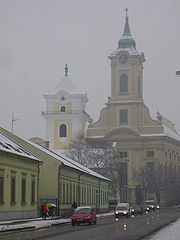
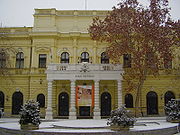
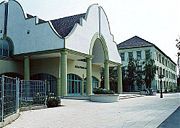
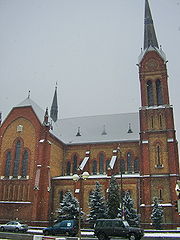 According to the 2001 census
According to the 2001 census
, the city has a total area of 193.94 km² (75 sq mi).
", which means "peaceful" in Hungarian, and "Csaba
", a popular Hungarian male given name of Turkish origin.
 The area has been inhabited since the ancient times. In the Iron Age
The area has been inhabited since the ancient times. In the Iron Age
the area had been conquered by the Scythians, by the Celts, then by the Huns
. After the Hungarian Conquest, there were many small villages in the area.
The village of Csaba was first mentioned in the 1330s. Besides Csaba, eight other villages stood where now the town stands. When the Turks conquered the southern and central parts of Hungary, and these territories became part of the Ottoman Empire, the town survived, but it became extinct during the fights against the Turks in the 17th century.
In 1715 Csaba is mentioned as a deserted place, but only one year later its name can be found in a document mentioning the tax-paying towns. It is likely that the new Csaba was founded by János György Harruckern, who earned distinction in the freedom fight against the Turks and bought the area of Békés county. By 1847 the town was among the twenty largest towns of Hungary, with a population of 22,000. Nevertheless, Csaba was still like a large village, with muddy streets and crowded houses.
By 1858 the railway line reached the town. This brought development; new houses and factories were built, the town began to prosper. Still, by the end of the 19th century the unemployment caused great tension, and in 1891 a revolt was oppressed by the help of Romanian soldiers. One of the most important person in the politics of the town was András L. Áchim, who founded a peasants' party and succeeded in having Békéscsaba elevated to the rank of "city with council".
World War I brought suffering to the town. Between 1919 and 1920 Békéscsaba was under Romanian occupation. After the Treaty of Trianon
Hungary lost its most important Southern cities, Arad
and Oradea
, and Békéscsaba had to take over their roles, becoming the most important town of the area.
Between the two world wars the recession caused poverty and unemployment, and a flood in 1925 didn't help, either.
During World War II battles weren't fought in the area, but two tragic events shook the town in 1944: between June 24 and 26th over 3,000 Jews
were sent to Auschwitz. A few of the Békéscsaba families who were lost at Auschwitz, Dachau.
On 21 September, the British and American Air Force bombed the railway station and its surroundings, killing more than 100 people. On 6 October 1944 the Soviet army occupied Békéscsaba.
During the Socialist times Békéscsaba became the county seat of Békés (1950), and began to develop into one of the most important centres of food industry of Hungary. After the change of regime in 1990 the industry got into a crisis, and lots of people lost their jobs. Today the crisis seems to be over and Békéscsaba is prospering again.
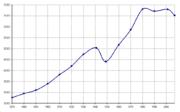 Ethnic groups (2001 census):
Ethnic groups (2001 census):
Religions (2001 census):
with: Beiuş
, Romania
Mikkeli
, Finland
Odorheiu Secuiesc
, Romania
Skoczów
, Poland
Tarnowskie Góry
, Poland
Trenčín
, Slovakia
Uzhhorod
, Ukraine
Wittenberg
, Germany
Zrenjanin
, Serbia
Penza
, Russia
Salonta
, Romania
Hungary
Hungary , officially the Republic of Hungary , is a landlocked country in Central Europe. It is situated in the Carpathian Basin and is bordered by Slovakia to the north, Ukraine and Romania to the east, Serbia and Croatia to the south, Slovenia to the southwest and Austria to the west. The...
, the capital of the county Békés
Békés (county)
Békés County , is an administrative division in south-eastern Hungary, on the border with Romania. It shares borders with the Hungarian counties Csongrád, Jász-Nagykun-Szolnok and Hajdú-Bihar. The capital of Békés county is Békéscsaba...
.
Geography




Census
A census is the procedure of systematically acquiring and recording information about the members of a given population. It is a regularly occurring and official count of a particular population. The term is used mostly in connection with national population and housing censuses; other common...
, the city has a total area of 193.94 km² (75 sq mi).
Name
The name of the city comes from the word "BékésBékés
Békés is a town in Békés county, Hungary. It lies about north of Békéscsaba and east of Budapest.- History :The area of the present town has been inhabited since ancient times, due to its good soil and proximity to rivers. After Hungarians conquered the area, Békés and its surroundings were the...
", which means "peaceful" in Hungarian, and "Csaba
Csaba
Csaba is a Hungarian given name for males. The name may originally mean either "shepherd" or "gift" in Hungarian. According to legend this was the name of the son of Attila the Hun.Individuals with the given name of Csaba:...
", a popular Hungarian male given name of Turkish origin.
History

Iron Age
The Iron Age is the archaeological period generally occurring after the Bronze Age, marked by the prevalent use of iron. The early period of the age is characterized by the widespread use of iron or steel. The adoption of such material coincided with other changes in society, including differing...
the area had been conquered by the Scythians, by the Celts, then by the Huns
Huns
The Huns were a group of nomadic people who, appearing from east of the Volga River, migrated into Europe c. AD 370 and established the vast Hunnic Empire there. Since de Guignes linked them with the Xiongnu, who had been northern neighbours of China 300 years prior to the emergence of the Huns,...
. After the Hungarian Conquest, there were many small villages in the area.
The village of Csaba was first mentioned in the 1330s. Besides Csaba, eight other villages stood where now the town stands. When the Turks conquered the southern and central parts of Hungary, and these territories became part of the Ottoman Empire, the town survived, but it became extinct during the fights against the Turks in the 17th century.
In 1715 Csaba is mentioned as a deserted place, but only one year later its name can be found in a document mentioning the tax-paying towns. It is likely that the new Csaba was founded by János György Harruckern, who earned distinction in the freedom fight against the Turks and bought the area of Békés county. By 1847 the town was among the twenty largest towns of Hungary, with a population of 22,000. Nevertheless, Csaba was still like a large village, with muddy streets and crowded houses.
By 1858 the railway line reached the town. This brought development; new houses and factories were built, the town began to prosper. Still, by the end of the 19th century the unemployment caused great tension, and in 1891 a revolt was oppressed by the help of Romanian soldiers. One of the most important person in the politics of the town was András L. Áchim, who founded a peasants' party and succeeded in having Békéscsaba elevated to the rank of "city with council".
World War I brought suffering to the town. Between 1919 and 1920 Békéscsaba was under Romanian occupation. After the Treaty of Trianon
Treaty of Trianon
The Treaty of Trianon was the peace agreement signed in 1920, at the end of World War I, between the Allies of World War I and Hungary . The treaty greatly redefined and reduced Hungary's borders. From its borders before World War I, it lost 72% of its territory, which was reduced from to...
Hungary lost its most important Southern cities, Arad
Arad, Romania
Arad is the capital city of Arad County, in western Romania, in the Crişana region, on the river Mureş.An important industrial center and transportation hub, Arad is also the seat of a Romanian Orthodox archbishop and features two universities, a Romanian Orthodox theological seminary, a training...
and Oradea
Oradea
Oradea is the capital city of Bihor County, in the Crișana region of north-western Romania. The city has a population of 204,477, according to the 2009 estimates. The wider Oradea metropolitan area has a total population of 245,832.-Geography:...
, and Békéscsaba had to take over their roles, becoming the most important town of the area.
Between the two world wars the recession caused poverty and unemployment, and a flood in 1925 didn't help, either.
During World War II battles weren't fought in the area, but two tragic events shook the town in 1944: between June 24 and 26th over 3,000 Jews
Jews
The Jews , also known as the Jewish people, are a nation and ethnoreligious group originating in the Israelites or Hebrews of the Ancient Near East. The Jewish ethnicity, nationality, and religion are strongly interrelated, as Judaism is the traditional faith of the Jewish nation...
were sent to Auschwitz. A few of the Békéscsaba families who were lost at Auschwitz, Dachau.
On 21 September, the British and American Air Force bombed the railway station and its surroundings, killing more than 100 people. On 6 October 1944 the Soviet army occupied Békéscsaba.
During the Socialist times Békéscsaba became the county seat of Békés (1950), and began to develop into one of the most important centres of food industry of Hungary. After the change of regime in 1990 the industry got into a crisis, and lots of people lost their jobs. Today the crisis seems to be over and Békéscsaba is prospering again.
Population

- Hungarians - 93.8%
- SlovaksSlovaksThe Slovaks, Slovak people, or Slovakians are a West Slavic people that primarily inhabit Slovakia and speak the Slovak language, which is closely related to the Czech language.Most Slovaks today live within the borders of the independent Slovakia...
- 6% - GermansGermansThe Germans are a Germanic ethnic group native to Central Europe. The English term Germans has referred to the German-speaking population of the Holy Roman Empire since the Late Middle Ages....
- 0.6% - RomaniansRomaniansThe Romanians are an ethnic group native to Romania, who speak Romanian; they are the majority inhabitants of Romania....
- 0.4%
Religions (2001 census):
- Roman Catholic - 24.2% (mainly Magyar descendants)
- Lutheran - 20.5% (mainly Slovak descendants)
- Calvinist - 10.9% (only Magyar descendants)
- Other - 2.1% (mainly ChristianChristianA Christian is a person who adheres to Christianity, an Abrahamic, monotheistic religion based on the life and teachings of Jesus of Nazareth as recorded in the Canonical gospels and the letters of the New Testament...
) - Atheist - 30.5%
- No answer, unknown - 10.8%
Tourist sights
- BaroqueBaroqueThe Baroque is a period and the style that used exaggerated motion and clear, easily interpreted detail to produce drama, tension, exuberance, and grandeur in sculpture, painting, literature, dance, and music...
church (18th century) - ClassicistClassicismClassicism, in the arts, refers generally to a high regard for classical antiquity, as setting standards for taste which the classicists seek to emulate. The art of classicism typically seeks to be formal and restrained: of the Discobolus Sir Kenneth Clark observed, "if we object to his restraint...
church (19th century) - City hall (designed by Miklós YblMiklós YblMiklós Ybl was one of Europe's leading architects in the mid to late nineteenth century as well as Hungary's most influential architect during his career...
, 1873) - Mihály MunkácsyMihály MunkácsyMihály Munkácsy was a Hungarian painter, who lived in Paris and earned international reputation with his genre pictures and large scale biblical paintings.-Early Years of Munkácsy:...
Museum - Mór JókaiMór JókaiMór Jókai , born Móric Jókay de Ásva , outside Hungary also known as Maurus Jokai, was a Hungarian dramatist and novelist.-Early life:...
Theatre - Slovak folklore museum
Born in Békéscsaba
- Ján Valašťan DolinskýJán Valaštan DolinskýJán Valašťan Dolinský was a Slovak composer, teacher, journalist, esperantist and collector of folk songs.He graduated from a teacher's institute and then worked as a teacher...
(1892–1965), Slovak composer - Károly KlimóKároly KlimóKároly Klimó is a Hungarian artist, one of the best known Hungarian artists of the present day. He is a non-figurative artist, member of the Széchenyi Academy of Literature and Arts....
(1936), artist - László VidovszkyLászló VidovszkyThe native form of this personal name is Vidovszky László. This article uses the Western name order.László Vidovszky is a Hungarian composer and pianist...
(1944), composer and pianist - Ádám SzepesiÁdám SzepesiÁdám Szepesi is a retired Hungarian high jumper.He was born in Békéscsaba. He finished fifth at the 1972 Summer Olympics with a jump of 2.18 metres. He became Hungarian high jump champion in 1972, rivalling with Endre Kelemen and István Major.His personal best jump was 2.21 metres, achieved in...
(1945), high jumper - Gyula HegyiGyula HegyiGyula Hegyi is a Hungarian politician and Member of the European Parliament for the Hungarian Socialist Party, part of the Party of European Socialists.-Biography:...
(1951), politician - Henrietta ÓnodiHenrietta ÓnodiHenrietta Ónodi is an Olympic gold winner Hungarian gymnast who competed at the 1992 and 1996 Olympics....
(1974), gymnast - Béla Szabados (1974), swimmer
- Eniko MihalikEnikő MihalikEnikő Mihalik is a Hungarian model who rose to prominence after placing 4th in the Elite Model Look 2002 and is known for her work with Dutch photography team Inez van Lamsweerde and Vinoodh Matadin.-Career:...
(1987), model
Twin towns — Sister cities
Békéscsaba is twinnedTown twinning
Twin towns and sister cities are two of many terms used to describe the cooperative agreements between towns, cities, and even counties in geographically and politically distinct areas to promote cultural and commercial ties.- Terminology :...
with: Beiuş
Beius
Beiuș is a city in Bihor County, Romania near the Apuseni Mountains. The river Crișul Negru flows through Beiuș, and the city administers a single village, Delani.-Population:According to the 2002 Census, Beiuş has a population of 10,996 inhabitants....
, Romania
Romania
Romania is a country located at the crossroads of Central and Southeastern Europe, on the Lower Danube, within and outside the Carpathian arch, bordering on the Black Sea...
Mikkeli
Mikkeli
Mikkeli is a town and municipality in Finland. It is located in what used to be the province of Eastern Finland and is part of the Southern Savonia region. The municipality has a population of and covers an area of of which is water...
, Finland
Finland
Finland , officially the Republic of Finland, is a Nordic country situated in the Fennoscandian region of Northern Europe. It is bordered by Sweden in the west, Norway in the north and Russia in the east, while Estonia lies to its south across the Gulf of Finland.Around 5.4 million people reside...
Odorheiu Secuiesc
Odorheiu Secuiesc
Odorheiu Secuiesc is the second-largest city in Harghita County, Transylvania, Romania. In its short form, it is also known as Odorhei in Romanian and Udvarhely in Hungarian...
, Romania
Romania
Romania is a country located at the crossroads of Central and Southeastern Europe, on the Lower Danube, within and outside the Carpathian arch, bordering on the Black Sea...
Skoczów
Skoczów
Skoczów is a town and the seat of Gmina Skoczów in Cieszyn County, Silesian Voivodeship, southern Poland with 14,783 inhabitants . It lies in the historical region of Cieszyn Silesia....
, Poland
Poland
Poland , officially the Republic of Poland , is a country in Central Europe bordered by Germany to the west; the Czech Republic and Slovakia to the south; Ukraine, Belarus and Lithuania to the east; and the Baltic Sea and Kaliningrad Oblast, a Russian exclave, to the north...
Tarnowskie Góry
Tarnowskie Góry
Tarnowskie Góry is a town in Silesia in southern Poland, near Katowice. Borders on the Upper Silesian Metropolitan Union - metropolis with the population of 2 millions. Located in the Silesian Highlands....
, Poland
Poland
Poland , officially the Republic of Poland , is a country in Central Europe bordered by Germany to the west; the Czech Republic and Slovakia to the south; Ukraine, Belarus and Lithuania to the east; and the Baltic Sea and Kaliningrad Oblast, a Russian exclave, to the north...
Trenčín
Trencín
Trenčín is a city in western Slovakia of the central Váh River valley near the Czech border, around from Bratislava. It has a population of more than 56,000, which makes it the ninth largest municipality of the country and is the seat of the Trenčín Region and the Trenčín District...
, Slovakia
Slovakia
The Slovak Republic is a landlocked state in Central Europe. It has a population of over five million and an area of about . Slovakia is bordered by the Czech Republic and Austria to the west, Poland to the north, Ukraine to the east and Hungary to the south...
Uzhhorod
Uzhhorod
Uzhhorod or Uzhgorod is a city located in western Ukraine, at the border with Slovakia and near the border with Hungary. It is the administrative center of the Zakarpattia Oblast , as well as the administrative center of the surrounding Uzhhorodskyi Raion within the oblast...
, Ukraine
Ukraine
Ukraine is a country in Eastern Europe. It has an area of 603,628 km², making it the second largest contiguous country on the European continent, after Russia...
Wittenberg
Wittenberg
Wittenberg, officially Lutherstadt Wittenberg, is a city in Germany in the Bundesland Saxony-Anhalt, on the river Elbe. It has a population of about 50,000....
, Germany
Germany
Germany , officially the Federal Republic of Germany , is a federal parliamentary republic in Europe. The country consists of 16 states while the capital and largest city is Berlin. Germany covers an area of 357,021 km2 and has a largely temperate seasonal climate...
Zrenjanin
Zrenjanin
Zrenjanin is a city and municipality located in the eastern part of Serbian province of Vojvodina. It is the administrative centre of the Central Banat District of Serbia...
, Serbia
Serbia
Serbia , officially the Republic of Serbia , is a landlocked country located at the crossroads of Central and Southeast Europe, covering the southern part of the Carpathian basin and the central part of the Balkans...
Penza
Penza
-Honors:A minor planet, 3189 Penza, discovered by Soviet astronomer Nikolai Stepanovich Chernykh in 1978, is named after the city.-Notable residents:...
, Russia
Russia
Russia or , officially known as both Russia and the Russian Federation , is a country in northern Eurasia. It is a federal semi-presidential republic, comprising 83 federal subjects...
Salonta
Salonta
Salonta is a city in Bihor County, Transylvania, Romania, near the Hungarian border.-Population:According to the last Romanian census from 2002, the city has a population of 18,074, made up of Hungarians , Romanians , Roma , and others .In terms of religion, 51.12% are Reformed , 36.46% Romanian...
, Romania
Romania
Romania is a country located at the crossroads of Central and Southeastern Europe, on the Lower Danube, within and outside the Carpathian arch, bordering on the Black Sea...

